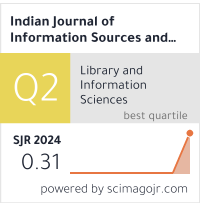Theoretical Framework for Restructuring Online Public Access Catalogue (OPAC) for the New Generation of Users
DOI:
https://doi.org/10.51983/ijiss.2013.3.1.376Keywords:
Library Cataloguing, Online Public Access Catalogue, Catalogue Standards, Features of Amazon, Features of GoogleAbstract
Library catalogues have embarked into a new world of chaos and begun to lose its value in information dissemination because of the profound impact of various factors which have taken place outside the library world. In this day, providing only bibliographic information is insufficient to meet the current demands of the users. OPACs should be able to give information, and also should be a vibrant and interactive tool. It should consist of many new components to raise the level of its patrons’ expectations. This paper is the authors’ final part of the research study. General features of OPACs were contemplated in the first part of analysis. In the second part of analysis, OPACs were compared with the features of Amazon and Google. Based on these two research studies, this paper proposes a comprehensive theoretical framework for restructuring the library catalogue to make it as a user centred tool and to fulfil present pressing demands.The suggested framework covers both the cataloguing standards and the computer technology to uplift the proficiency of OPACs for the new generation of users.
References
Tamar Sadeh, “User-Centric Solutions for Scholarly Research in the Library”, LIBER Quarterly, Vol.17, No.3/4, 2007.
J. Law, “Academic libraries and the struggle to remain relevant: Why research is conducted elsewhere”, Paper retrieved from http://www. serialssolutions.com/downloads/John-Law-Sydney-Online-2008.pdf, 2009. Accessed on (Accessed on 04th June 2011)
MM Mashroofa, “Requirements of Net Generation towards university libraries in Sri Lanka”, Journal of the University Librarian Associate of Sri Lanka, Vol.16, No.2, 2012.
TanjaMercun, MajaŽumer, “New generation of catalogues for the new generation of users: A comparison of six library catalogues”, Program, Vol.42 No.3, pp: 243-326, 2008.
AlenkaSauperl and Jerry D. Saye, “Speculation in Documentation: Have we made any progress? Catalogues of the future revisited”, Journal of Documentation, Vol. 65, No.3, pp.500-514, 2009.
Tam, Winnie, Cox, Andrew M. and Bussey, A, “Student user preferences for features of next-generation OPACs: a case study of University of Sheffield international students”, Program, Vol.43, No.4, pp. 349-374, 2009.
H Kalilur Rahman and J Dominic, “Studies on Features of Online Public Access Catalogues of Academic Libraries in Gulf Cooperation Council Nations”, presented at International Conference on Innovation – Driven Librarianship: Expectations of Librarians and Library Users, SRM University, Chennai, ISBN 9788184652123, pp.351-357, 2010
H Kalilur Rahman and J Dominic, “An Analytical Study of Online Public Access Catalogues in Comparison with Features of Amazon and Google: A Checklist Approach”, Asian Journal of Information Science and Technology, ISSN: 2231-6108, Vol.2, No.1, pp.17-23, 2012.
MboniRuzegea, “The Usability of OPAC Interface Features: The Perspective of Postgraduate Students at International Islamic University Malaysia (IIUM)”, Library Philosophy and Practice (e-journal), 2012. Accessed on 17-Dec-2012.
Downloads
Published
How to Cite
Issue
Section
License
Copyright (c) 2013 The Research Publication

This work is licensed under a Creative Commons Attribution-NonCommercial-NoDerivatives 4.0 International License.









